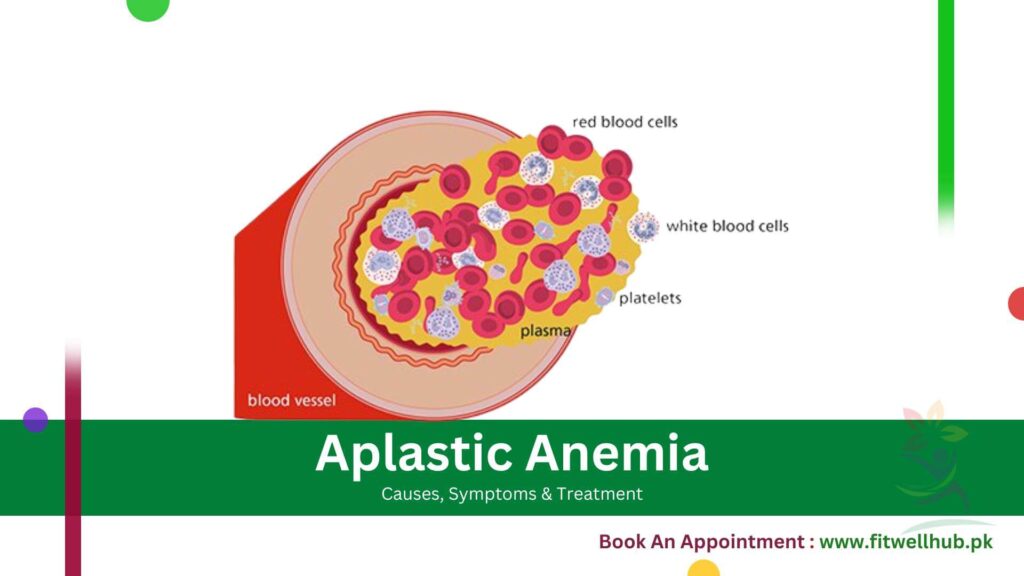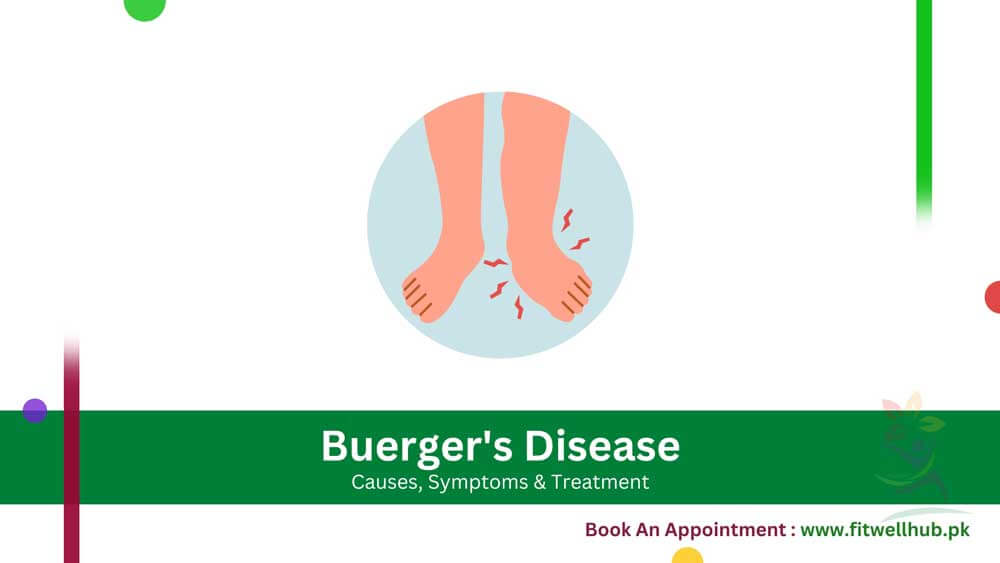Aplastic anemia is a serious condition in which the bone marrow fails to produce sufficient amounts of red blood cells, white blood cells, and platelets. It is a rare disease in which bone marrow failure causes fatigue, a higher risk of infections, and increased bleeding tendencies. Aplastic anemia can be acquired or inherited and is sometimes linked to autoimmune diseases, toxins, or certain medications. Early diagnosis and immediate treatment are important. If left untreated, aplastic anemia can become life-threatening.
Quick Links
ToggleIn Pakistan, 3.5 out of every million people suffer from aplastic anemia (AA), with a slight male predominance (male-to-female ratio of 1.5:1). At FitwellHub, we use telemedicine & AI technologies to provide remote consultations and advanced imaging. This helps provide faster, personalized care to patients across Pakistan, improving accessibility and treatment outcomes.
Symptoms
A few common symptoms of aplastic anemia are:
1- Fatigue
Because the individual does not have enough red blood cells, he feels tired and weak due to a lack of oxygen throughout the body.
2- Frequent Infections
The number of white blood cells is very low, which renders the body unable to fight off many infections that might come in. Consequently, these people tend to fall ill frequently and take a longer time than usual to recover from their illness.
3- Easy Bruising or Bleeding
Individuals tend to get bruises often or sometimes bleed longer than usual for minor cuts and scrapes resulting from the low amount of platelets in the blood.
4- Shortness of breath
Dropping below normal levels of red blood cells causes shortness of breath when doing anything strenuous; this is because the body receives less oxygen compared to its demand.
5- Pale skin
The reduction in red blood cells means that the skin is pale because there is less reverse flow of blood with oxygen around the body.
When to See a Doctor
If you are suffering from fatigue, frequent infections, easy bruising, or prolonged bleeding, it is important to consult with a healthcare provider. It develops rapidly and requires early treatment to prevent life-threatening complications like severe infections or bleeding. If you observe any of these symptoms, consult a healthcare provider immediately.
At FitwellHub, our hematologists are available to provide expert diagnosis and treatment. Ready to take the first step toward a healthier, happier you? Book an appointment with us today, and let our experts guide you on your wellness journey!
Causes Aplastic Anemia
The main causes of aplastic anemia are:
- Autoimmune Diseases: Conditions like lupus or rheumatoid arthritis can cause the immune system to attack the bone marrow, impairing blood cell production.
- Exposure to Toxins: Prolonged exposure to toxic chemicals such as pesticides, benzene, and arsenic can damage the bone marrow, reducing its ability to produce blood cells.
- Medications: Certain drugs, including chemotherapy, antibiotics, and anticonvulsants, can harm the bone marrow, leading to aplastic anemia.
- Radiation Therapy: Radiation therapy, especially near bone areas, can destroy bone marrow and reduce blood cell production.
- Viral Infections: Viruses like Epstein-Barr and HIV can cause bone marrow inflammation or direct damage, leading to aplastic anemia.
Risk Factors
Consequently, the body may reduce its capacity to generate blood cells. A family history of inherited bone marrow failure disorders is another possible risk factor. Certain medications used to treat cancer and autoimmune diseases have the potential to further damage an individual’s bone marrow. Other causative agents include viral infections, including hepatitis and HIV, and high doses of radiation, especially during cancer treatment.
Complications
The causes of aplastic anemia can lead to serious complications if left untreated.:
- Severe Infections: A deficiency of white blood cells in affected individuals increases the vulnerability of individuals to developing infections. These infections can become life-threatening if not treated promptly.
- Uncontrolled Bleeding: A reduced platelet count does not directly cause injuries but significantly impairs the blood’s ability to clot. This results in prolonged and severe bleeding even from minor injuries, which may require immediate treatment.
- Heart Problems: The heart has to work hard to compensate for the deficiency of oxygen-carrying red blood cells. It causes complications like arrhythmias, heart failure, or enlargement of the heart.
- Blood Cancers: Individuals are at a higher risk of developing leukemia or other blood-related cancers due to long-term damage to the bone marrow.
- Organ Failure: Severe aplastic anemia can lead to organ failure, as the body struggles to supply enough oxygen and nutrients to vital organs like the kidneys, liver, and brain.
Prevention
Although you cannot always prevent aplastic anemia, you can reduce the risk by following certain measures:
- Avoid Toxins: Reduce your exposure to dangerous substances like industrial solvents and pesticides, as they may harm your bone marrow and increase your risk of developing.
- Practice Hygiene: Avoid contact with sick people and practice proper cleanliness to prevent infections. It lowers the risk of developing viral infections.
- Monitor Medications: If you are on medications that can affect the bone marrow, be sure to work with your doctor to monitor their effects and make changes in medication as needed.
- Vaccination: Vaccinate yourself against certain viruses, like hepatitis B. It will reduce the risk of viral infections.
- Regular Check-Ups: Routine health check-ups identify early symptoms of bone marrow problems, allowing for timely treatment.
We provide preventive care services at FitwellHub to assist in managing the risk factors. Visit our lab services page to learn more.
Diagnosis
A combination of clinical evaluations and laboratory tests to diagnose aplastic anemia:
1- Complete Blood Count (CBC)
Blood Count CBC measures the concentration of RBCs, WBCs, and platelets in the blood. It can quantify the overall blood cell deficiency. This is commonly performed to confirm aplastic anemia.
2- Bone Marrow Biopsy
A doctor performs a bone marrow biopsy to evaluate the function of the bone marrow and determine whether it is creating enough blood cells. This is a crucial aplastic anemia diagnostic tool.
3- Reticulocyte Count
This test measures the quantity of reticulocytes, or immature red blood cells, in the blood to provide information about bone marrow activity.
4- Liver Function Tests
This test is performed to evaluate the general health of the organs and identify anemia-related liver problems.
5- Imaging Scans
Imaging tests, such as MRIs and X-rays, are used to identify underlying diseases that are causing bone marrow failure.
We provide a variety of diagnostic tests at FitwellHub to help properly identify aplastic anemia. Visit our lab for more information.
Treatment
Treatment depends on the degree of severity and may involve the following treatment methods:
| Treatment | Description |
|---|---|
| Blood Transfusions | Temporary solution to manage symptoms by increasing red blood cells, white blood cells, and platelets while other treatments take effect. |
| Bone Marrow Transplant | The best treatment for severe aplastic anemia, where damaged bone marrow is replaced with healthy bone marrow cells. |
| Immunosuppressive Therapy | Uses immunosuppressive medications to prevent the immune system from attacking the bone marrow, restoring normal blood cell production. |
| Medications | Prescribed to boost bone marrow activity and increase blood cell counts, including growth factors or corticosteroids. |
Medications
The following drugs are used to treat aplastic anemia:
- Immunosuppressants: Cyclosporine and antithymocyte globulin (ATG) suppress the immune system and prevent it from attacking the bone marrow.
- Corticosteroids: Steroids like prednisone reduce inflammation and, in some cases, also improve the function of bone marrow.
- Antibiotics: Antibiotics are used to treat or prevent bacterial infections in patients with low white blood cell counts because of the increased risk of infection.
- Antivirals: Antiviral medicines can be used to treat and prevent viral infections in individuals with aplastic anemia and may be especially needed if doctors think the cause of the aplastic anemia is related to a virus.
- Growth Factors: These medications, like erythropoietin, may be given to stimulate red blood cell production and treat symptoms of anemia.
We provide a variety of drugs at FitwellHub to treat aplastic anemia. Visit our pharmacy to explore available options and consult with our experts.
Frequently Ask Questions (FAQ’s)
Aplastic anemia is a disease in which the bone marrow fails to produce sufficient blood cells. It causes fatigue, frequent infections, and bleeding issues.
The causes of aplastic anemia are autoimmune diseases, exposure to toxins, medications, viral infections, and radiation therapy; all of these can damage the bone marrow.
For the diagnosis of aplastic anemia, blood tests, bone marrow biopsies, and other diagnostic procedures are used to evaluate bone marrow function and blood cell levels.
Some patients achieve a cure for aplastic anemia through bone marrow transplant. Other kinds of treatments, such as immunosuppressive therapy and medicines, assist in symptom alleviation by improving the quality of life.
Untreated aplastic anemia increases the risk of serious infections, hemorrhage, and organ failure, all of which can be fatal. However, many people can properly manage the illness when given the right care.











